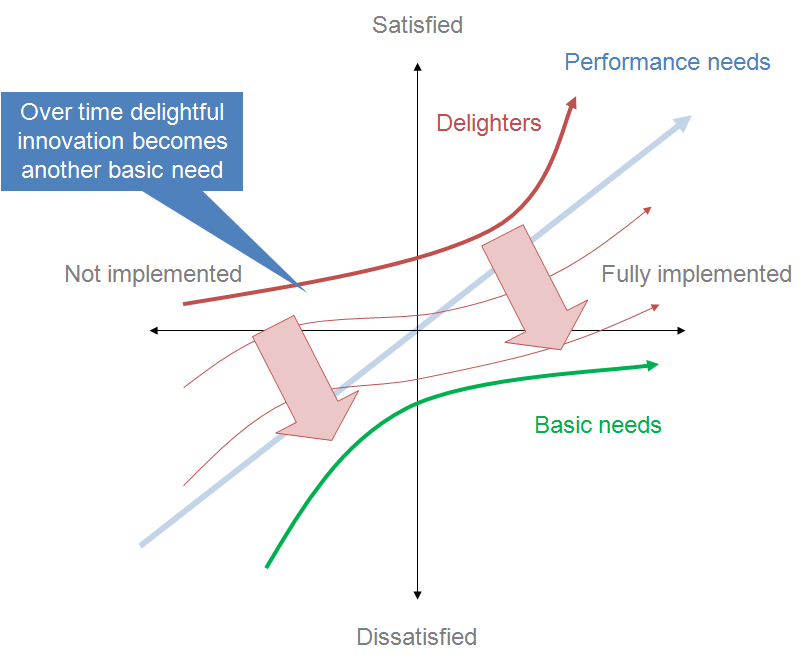
· Delight Features: Features that are not expected and that when successfully delivered can exponentially increase the customer’s perception of the brand, product, or service.
· Performance Features: The features that are expected to perform in a way that provides a competitive advantage, or why the customer selected the product over a competitive product.
· Minimum Features: These are minimum expected features, the lack of which can exponentially decrease the perceived value of the brand, product, or service.
· Undesired Features: While not common, these are features whereby their existence would lead to negative perception — that is the customer does not want these features to be present.
“There is a scientific and mathematical approach to engaging with customers to understand subjective desires and shape overall product and service direction.”

The Kano Model contains factors that not only encompass the product and service features — but *how* successfully those products and services are delivered. The same factors of delight, performance, minimum, and undesired can be mapped to the physical interaction with our brand in the delivery of the products or services.
“Given the importance of customer service and customer engagement, as leaders we should also work to define those brand and team member attributes which contribute to success.”
Other aspects of the Kano Model is that it can be used to help define and prioritize new products and services that should be offered by the brand. There is a scientific and mathematical approach to engaging with customers to understand desires and shape product and service direction. Given the importance of customer service and engagement, as leaders we should also work to define those brand and team member attributes which contribute to success.
What are the minimum expectations of the brand and team as it relates to the customer experience? What can be done to provide a competitive advantage? And what would our engagement look like if we really wanted to generate delight? And what should we *not* be doing? These subjective qualities can also be mapped to customer satisfaction surveys. We also develop and use associated metrics to reward employees and team members for performance that delights our customers.
In doing some client research I stumbled onto an article that presented 196 questions that business owners should ask themselves when planning a marketing strategy. Yet, there wasn’t a single question related to the business owner asking their customers anything at all, let alone asking the customer what they wanted from the business owner. In previous posts we’ve discussed the importance of differentiation, and how that process should start with asking why you do what you do, and why should anyone care.
Creating a good marketing strategy includes a value proposition that directly maps your points of differentiation (that is, your why) to the client’s needs and desires (their why.) In fact, every marketing optimization strategy emphasizes understanding customer motivation as the most critical factor to success. And the best way to understand client motivation is to ask them.
In a world of big data and marketing technology solutions, it is so easy to get caught up in the science of marketing strategies and market research, that it is easy to forget the humanity that lies behind the data. But while data can tell you what someone did, it can rarely (if ever) tell you why they did it. Sometimes it is much more powerful (and even easier) to simply ask what the market wants and why.
One of the best techniques, and admittedly sometimes easiest to skip, is actually picking up the phone to talk to real people. It doesn’t have to be a huge focus group. In fact, there are some downsides to doing more formal focus groups, or even informally as a group. Group dynamics introduce a whole set of other factors that need to be accounted for.
Instead, talking to individuals, even if it is just one person is valuable. By taking a personal interest, using dialogue instead of a survey, develops a much more nuanced understanding of the client’s goals, experienced pains, and desired gains. While it must remain in context of being a sample size of one, at minimum the feedback presents a picture of “people like this” which is what developing a marketing persona is about. The other upside is, it create a more intimate knowledge, understanding, and connection with the person you are brainstorming with.
While market research and persona development is something that Idea Spring does when helping construct marketing strategies for our clients, the concept of understanding client motivation and asking questions is something business owners should do throughout on-going client interactions.
Successful marketing strategies depend on knowing more than the logical client jobs, goals and tasks. It is equally important, if not more so, to really understand the emotional drivers that underlie those needs. Truly knowing your target audience is a critical key to both gaining and keeping clients.
So how can business owners know what those emotional drivers are? Ask. Develop open-ended questions that help uncover what really matters to your client. Ask questions that expand beyond a direct connection to your business products or services. Often times new opportunities for adding value and differentiating your business and yourself emerge as you gain a more holistic picture of what matters most to your clients.
Below are some questions that can as starting points. The questions should be modified to better reflect your specific business, and the person you are brainstorming with. Frame the questions in context, and in a way that reflects your authentic interest in learning more about the person and their motivation. If you aren’t authentically interested in your clients, it may be time to consider a different line of work.
Go beyond the business-transaction level, and dig deeper to understand the experienced pains and desired gains. Be sure to dig deeper by asking follow-on questions. For example, if someone answers “I don’t know… I guess because we trust you.” Then ask why they trust you. And if they respond with why they trust you, ask what it is about those actions that they correlate with trust.